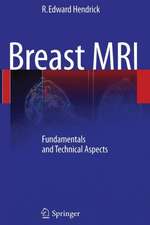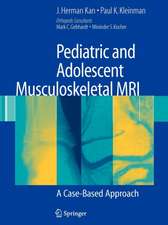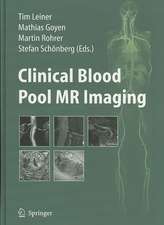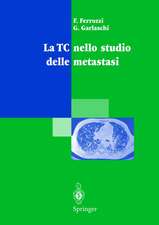Reading MRI of the Prostate: A Practical Guide
Editat de Ananya Panda, Vikas Gulani, Lee Ponskyen Limba Engleză Hardback – 2 ian 2020
Reading MRI of the Prostate aims to help urologists and radiologists understand the evaluation and interpretation of prostate MRIs.
Preț: 840.24 lei
Preț vechi: 884.47 lei
-5% Nou
Puncte Express: 1260
Preț estimativ în valută:
160.80€ • 167.26$ • 132.75£
160.80€ • 167.26$ • 132.75£
Carte tipărită la comandă
Livrare economică 10-16 aprilie
Preluare comenzi: 021 569.72.76
Specificații
ISBN-13: 9783319993553
ISBN-10: 3319993550
Pagini: 240
Ilustrații: XIV, 111 p. 72 illus., 20 illus. in color.
Dimensiuni: 155 x 235 x 14 mm
Ediția:1st ed. 2020
Editura: Springer International Publishing
Colecția Springer
Locul publicării:Cham, Switzerland
ISBN-10: 3319993550
Pagini: 240
Ilustrații: XIV, 111 p. 72 illus., 20 illus. in color.
Dimensiuni: 155 x 235 x 14 mm
Ediția:1st ed. 2020
Editura: Springer International Publishing
Colecția Springer
Locul publicării:Cham, Switzerland
Cuprins
1. Basic Understanding of MRI.- 2. Normal Prostate Anatomy on MRI.- 3. Prostate Cancer.- 4. PIRAD System.- 5. Lymph Node Evaluation of Prostate Cancer.- 6. Bone Metastases on MRI.- 7. Advanced Imaging Techniques.
Notă biografică
Ananya Panda currently holds an academic appointment of Assistant Professor at the Mayo Clinic, Rochester while pursuing a fellowship in Nuclear Radiology. She completed her primary Radiology Residency from All India Institute of Medical Sciences (AIIMS), New Delhi, India in 2013. Thereafter, she spent 3 years at AIIMS as a senior resident invested in patient care and academic teaching. She subsequently pursued a 2-year postdoctoral fellowship in MRI at Case Western Reserve University, Cleveland, Ohio working on the clinical translation of quantitative MRI and exploring utility of multiparametric imaging, with a focus on prostate imaging. She is the recipient of several awards including Radiology Society of North America (RSNA) Trainee Research Awards in 2018 and 2019 for research work in prostate and pancreatic cancer and the Gold Medal for the Best Radiology Resident in 2014.
She was admitted as a Fellow of the Royal College of Radiology (UK) in 2018. Herclinical interests lie in all aspects of imaging, particularly multiparametric imaging to solve challenging clinical questions in different areas including body imaging and nuclear radiology.
Vikas Gulani is the Chair and Fred J. Hodges Professor of Radiology at the University of Michigan, Ann Arbor. Dr. Gulani received his B.S. in Chemical Engineering at UCLA. He then moved to the University of Illinois at Urbana- Champaign, completing his Ph.D. in Physiology under Prof. Paul C. Lauterbur, the winner of the 2003 Nobel Prize for Medicine or Physiology for the invention of Magnetic Resonance Imaging (MRI). After his MD also at Illinois, he completed a Diagnostic Radiology residency and fellowship in Body MRI at the University of Michigan. During residency, he spent a year at the University of Würzburg in Germany, working as a research postdoctoral fellow in the Department of Physics. He joined the faculty in the Department of Radiology at Case Western Reserve University and University Hospitals after training, and was the Joseph T. Wearn Professor, Professor of Radiology, Biomedical Engineering, and Urology, a member of the Case Comprehensive Cancer Center, and the Director of MRI for the University Hospitals system. His clinical interests include all abdominal/pelvic imaging, but particularly prostate, liver, and renal MRI and MR angiography. His past and present research interests in MRI include MR fingerprinting and quantitative MRI, parallel imaging and rapid acquisitions, diffusion tensor imaging and diffusion anisotropy, perfusion MRI, MR microscopy, and body MRI. His most recent work includes the invention with his collaborators of the MR fingerprinting technology, and he has spearheaded the effort to bring this work to clinical fruition, bringing together his engineering and clinical knowledge and scientific and industry collaborations. In prostate imaging, he has worked on the clinical translation of MR fingerprinting, development of an all-quantitative MRI exam, a rapid screening protocol, and in-bore prostate biopsies. As Chair, his primary goal is to build a compassionate workplace that strives toward excellence.
Lee Ponsky attended University of Rochester as an undergraduate and then Case Western Reserve University School of Medicine. He began his training at the Cleveland Clinic and completed his residency and extended his training to do a research fellowship in urologic oncology, followed by an additional fellowship in Advanced Urologic Laparoscopy and Endourology. In 2005, Lee joined the faculty at University Hospitals, Case Western Reserve University School of Medicine, and is currently the Chairman of the Department of Urology and Director of the Urology Institute. He is a Professor of Urology and holds the Leo and Charlotte Goldberg Chair in Advanced Surgical Therapies and a Master Clinician in Urologic Oncology. He has over 100 publications and has been
invitedas a visiting professor at numerous national and international conferences and institutions. Lee is the co-principal investigator on an NIH RO1 grant. He is the Editor-in-Chief of a textbook on Robotic Radiosurgery and has authored more than 12 textbook chapters. Lee recently founded IOIO Studio, a tattoo removal, and MediSpa Studio and Walden Medical, a medical device company. Lee has received numerous accolades for his medical contributions as well as for his role as the founder of MedWish International in 1993. MedWish is a not-forprofit organization that saves lives and the environment by repurposing discarded medical supplies and equipment to provide humanitarian aid in developing countries. His recognitions include U.S. Congressional Recognition, Crain’s Forty under Forty, as one of Northeast Ohio’s most influential people under the age of 40, Cleveland Upstander: Portraits of Courage, the recipient of the Golden Doc Award, from the Arnold P. Gold Foundation, and received the Rescuer of Humanity Award from Project Love, which recognizes and honors an individual or an organization of national or international stature, which has chosen to use their leadership beyond professional or institutional requirements to positively change the course of humanity. He has also been recognized by the Manhattan Institute in New York with the Richard Cornuelle Award for Social Entrepreneurship, for originating and effectively implemented a new nonprofit organization providing direct services to those in need. In 2011, he was recognized by Smart Business as the nonprofit board executive of the year and also received the University Hospitals Case Medical Center, Urology Institute Faculty Teaching Award from his students and residents, for recognition of outstanding commitment and efforts to student and resident teaching. In 2019, he received the Champion of Integrity Award by the Better Business Bureau for consistently displaying an aggressive commitment to ethical, honest, andfair business practices. Lee also serves as a founding board member of the nonprofit MedWorks, which provides free healthcare to the uninsured and underinsured.
She was admitted as a Fellow of the Royal College of Radiology (UK) in 2018. Herclinical interests lie in all aspects of imaging, particularly multiparametric imaging to solve challenging clinical questions in different areas including body imaging and nuclear radiology.
Vikas Gulani is the Chair and Fred J. Hodges Professor of Radiology at the University of Michigan, Ann Arbor. Dr. Gulani received his B.S. in Chemical Engineering at UCLA. He then moved to the University of Illinois at Urbana- Champaign, completing his Ph.D. in Physiology under Prof. Paul C. Lauterbur, the winner of the 2003 Nobel Prize for Medicine or Physiology for the invention of Magnetic Resonance Imaging (MRI). After his MD also at Illinois, he completed a Diagnostic Radiology residency and fellowship in Body MRI at the University of Michigan. During residency, he spent a year at the University of Würzburg in Germany, working as a research postdoctoral fellow in the Department of Physics. He joined the faculty in the Department of Radiology at Case Western Reserve University and University Hospitals after training, and was the Joseph T. Wearn Professor, Professor of Radiology, Biomedical Engineering, and Urology, a member of the Case Comprehensive Cancer Center, and the Director of MRI for the University Hospitals system. His clinical interests include all abdominal/pelvic imaging, but particularly prostate, liver, and renal MRI and MR angiography. His past and present research interests in MRI include MR fingerprinting and quantitative MRI, parallel imaging and rapid acquisitions, diffusion tensor imaging and diffusion anisotropy, perfusion MRI, MR microscopy, and body MRI. His most recent work includes the invention with his collaborators of the MR fingerprinting technology, and he has spearheaded the effort to bring this work to clinical fruition, bringing together his engineering and clinical knowledge and scientific and industry collaborations. In prostate imaging, he has worked on the clinical translation of MR fingerprinting, development of an all-quantitative MRI exam, a rapid screening protocol, and in-bore prostate biopsies. As Chair, his primary goal is to build a compassionate workplace that strives toward excellence.
Lee Ponsky attended University of Rochester as an undergraduate and then Case Western Reserve University School of Medicine. He began his training at the Cleveland Clinic and completed his residency and extended his training to do a research fellowship in urologic oncology, followed by an additional fellowship in Advanced Urologic Laparoscopy and Endourology. In 2005, Lee joined the faculty at University Hospitals, Case Western Reserve University School of Medicine, and is currently the Chairman of the Department of Urology and Director of the Urology Institute. He is a Professor of Urology and holds the Leo and Charlotte Goldberg Chair in Advanced Surgical Therapies and a Master Clinician in Urologic Oncology. He has over 100 publications and has been
invitedas a visiting professor at numerous national and international conferences and institutions. Lee is the co-principal investigator on an NIH RO1 grant. He is the Editor-in-Chief of a textbook on Robotic Radiosurgery and has authored more than 12 textbook chapters. Lee recently founded IOIO Studio, a tattoo removal, and MediSpa Studio and Walden Medical, a medical device company. Lee has received numerous accolades for his medical contributions as well as for his role as the founder of MedWish International in 1993. MedWish is a not-forprofit organization that saves lives and the environment by repurposing discarded medical supplies and equipment to provide humanitarian aid in developing countries. His recognitions include U.S. Congressional Recognition, Crain’s Forty under Forty, as one of Northeast Ohio’s most influential people under the age of 40, Cleveland Upstander: Portraits of Courage, the recipient of the Golden Doc Award, from the Arnold P. Gold Foundation, and received the Rescuer of Humanity Award from Project Love, which recognizes and honors an individual or an organization of national or international stature, which has chosen to use their leadership beyond professional or institutional requirements to positively change the course of humanity. He has also been recognized by the Manhattan Institute in New York with the Richard Cornuelle Award for Social Entrepreneurship, for originating and effectively implemented a new nonprofit organization providing direct services to those in need. In 2011, he was recognized by Smart Business as the nonprofit board executive of the year and also received the University Hospitals Case Medical Center, Urology Institute Faculty Teaching Award from his students and residents, for recognition of outstanding commitment and efforts to student and resident teaching. In 2019, he received the Champion of Integrity Award by the Better Business Bureau for consistently displaying an aggressive commitment to ethical, honest, andfair business practices. Lee also serves as a founding board member of the nonprofit MedWorks, which provides free healthcare to the uninsured and underinsured.
Textul de pe ultima copertă
This book provides a concise guide to prostate cancer imaging. Beginning with normal MR anatomy, the book details the various components of a typical mpMRI protocol and discusses MR interpretation and reporting under PI-RADS version 2 guidelines. MR appearances of atypical locations of prostate cancer, common tumor mimics, MR-guided biopsy strategies, and the role of active surveillance are also covered.
Reading MRI of the Prostate aims to help urologists and radiologists understand the evaluation and interpretation of prostate MRIs.
Reading MRI of the Prostate aims to help urologists and radiologists understand the evaluation and interpretation of prostate MRIs.
Caracteristici
Contains case examples to allow the reader to test themselves Highly illustrated with figures and photos that show MRI procedures Written by experts in the field



























